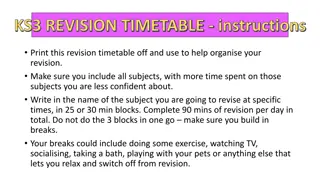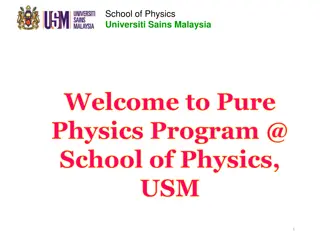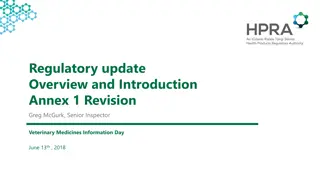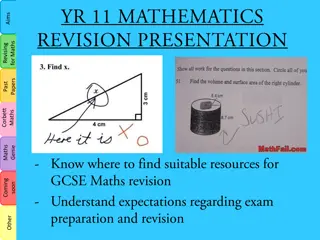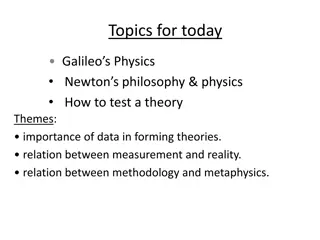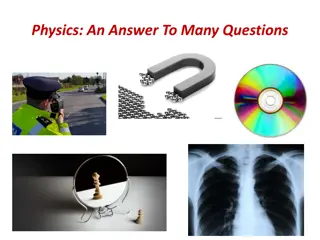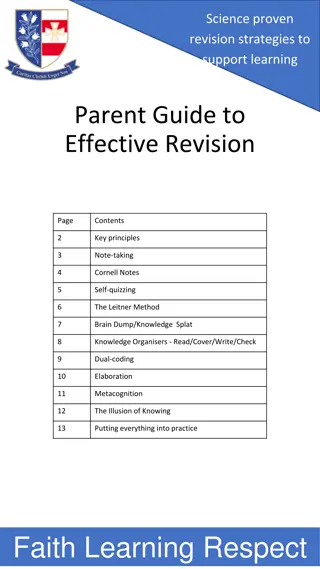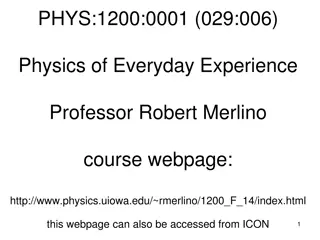Physics Practical Revision Guide
Explore practical experiments in physics including determining specific heat capacity, investigating thermal insulators, resistance, calculating densities of solid objects and liquids, and more. Get hands-on with measuring mass, volume, temperature changes, and conducting circuit experiments. Enhance your understanding of foundational physics concepts through engaging activities and methodologies.
Download Presentation

Please find below an Image/Link to download the presentation.
The content on the website is provided AS IS for your information and personal use only. It may not be sold, licensed, or shared on other websites without obtaining consent from the author.If you encounter any issues during the download, it is possible that the publisher has removed the file from their server.
You are allowed to download the files provided on this website for personal or commercial use, subject to the condition that they are used lawfully. All files are the property of their respective owners.
The content on the website is provided AS IS for your information and personal use only. It may not be sold, licensed, or shared on other websites without obtaining consent from the author.
E N D
Presentation Transcript
Required Practical Revision
Determining Specific Heat Capacity Use a balance to determine the mass of the block. Set up the equipment making sure the block in insulated. Turn on the power supply once the immersion heater is inserted into the block. Use a joulemeter to measure the amount of energy being supplied to the block. Measure the temperature change. Use the SHC equation to determine the SHC of the material.
Investigating Thermal Insulators Wrap each beaker in the required material/ layers of materials. Measure the same volume of water into each beaker. Ensure each beaker starts with water at the same temperature. Start the timer. Measure the temperature change. Smallest temperature change is best insulator
Investigating resistance and investigating electrical components Set up a circuit as shown. Turn the circuit on. Record the ammeter and voltmeter readings. Move the variable resistor to 8 more points. Record the current and voltage each time. Draw a graph of current against voltage. Calculate the gradient of the graph to work out the resistance.
Measuring density of a regular solid object Work out the volume using a ruler. Determine the mass using a mass balance. Divide mass by volume to get the density.
Measuring density of a liquid Determine the mass. Weigh the measuring cylinder without liquid first. Weigh a second time with the liquid. Work out the difference. Work out the volume using a measuring cylinder. Calculate the density.
Measuring density of an irregular solid object Determine the mass using a mass balance. Work out the volume using the Eureka Can . Measure the amount of water that is displaced into a measuring cylinder to work out the volume of the object. Divide mass by volume to get the density.
Investigating the relationship between force and extension for a spring Suspend a spring from a clamp. Measure the length of the spring. Add weights to the spring one by one and record the amount of extension from the original length. Draw a graph of force (y-axis) against extension (x-axis) Calculate the gradient to determine the spring constant for the spring used (the amount of force needed to stretch a spring by 1cm) This is the Hooke s Law Experiment
Investigating the relationship between force and acceleration Set up the equipment as shown. Use a top pan balance to determine the mass of the trolley Ensure the ramp/surface is horizontal. Connect the light-gates to a computer to record the acceleration at each attempt. Release the weight and record the acceleration through the light-gate. Repeat the experiment adding 50g mass each time. Draw a graph of force against acceleration to determine the relationship.
Investigating plane waves in a ripple tank A stopwatch, ruler and ripple tank are required. Count the number of waves that pass a point in 10 seconds. Divide the number of waves by 10 seconds to calculate the frequency. Use a timer to determine how long it takes for a wave to travel a certain distance. Divide the speed of the wave by dividing the distance by the time taken. Use the frequency and speed to determine the wavelength of the waves produced
Investigate the reflection and refractions of light 2 parts Refraction Shine light through a glass block at an angle. Draw crosses to show where the light travels. Join the crosses to determine how much the light has been refracted. Angle i is the incidence angle Angle r is the refractive angle
Investigate the reflection and refractions of light 2 parts Reflection Shine the light onto a mirror. Draw crosses to show the path of the light rays. Join the crosses to show how the light has been reflected. Angle i is the incidence angle Angle r is the angle of reflection If the results are correct the angle of incidence = angle of reflection
Investigating infrared radiation Fill two beakers with water at the same temperature. Cover one with a dull black material (e.g felt). Cover the seconds with a shiny silver material (e.g. foil). Place both beakers the same distance from a heater for the same amount of time. Record the temperature changes. Biggest temperature change is the best absorber of infrared radiation.

 undefined
undefined









